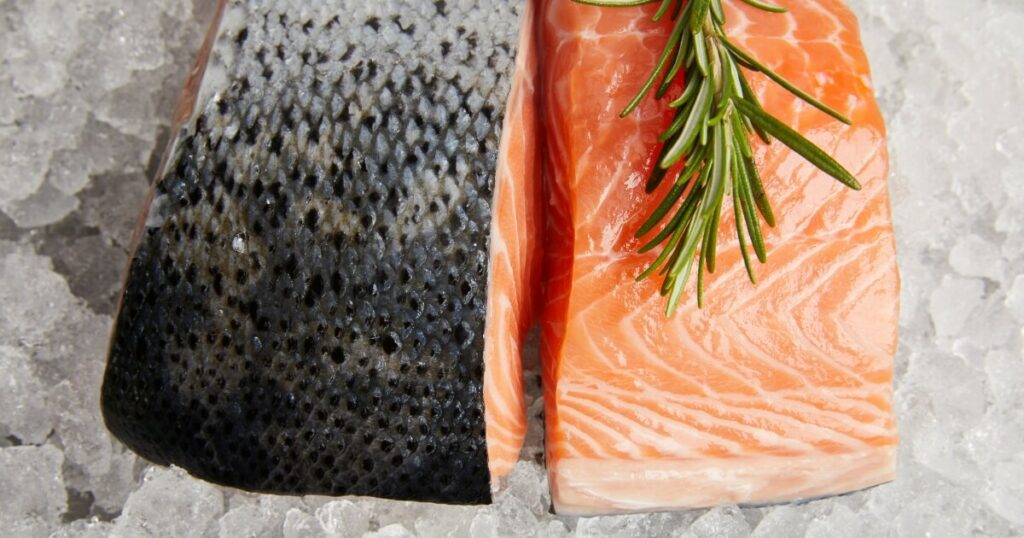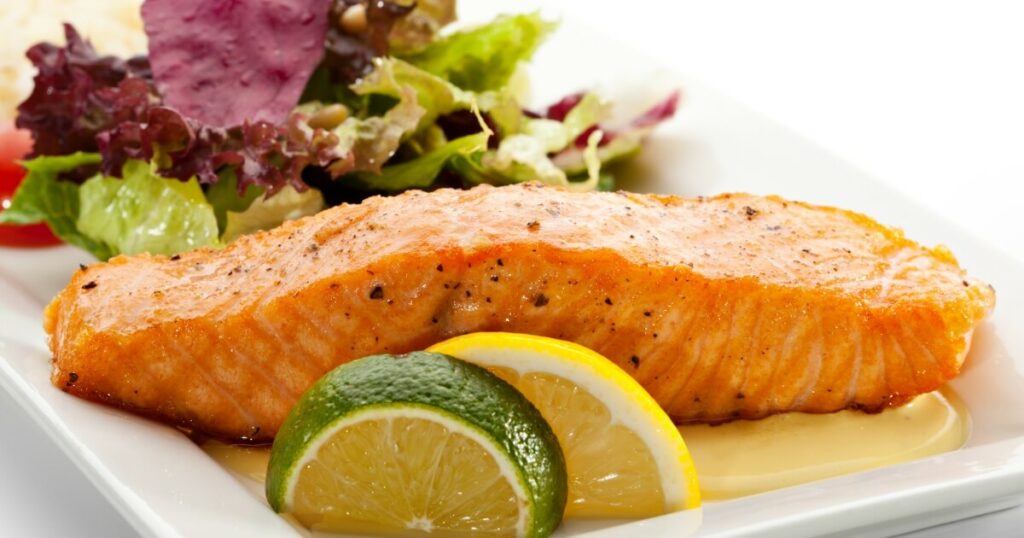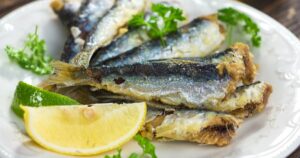Salmon, a favorite among seafood lovers, is known for its rich, distinct flavor and versatility in the kitchen. This popular fish is a staple in various cuisines around the world, from the sushi bars of Japan to the grills of American barbecues.
The taste of salmon is often described as a unique combination of rich, buttery flavors with a hint of natural sweetness. It’s not as fishy as some other seafood options, making it a easy choice for those new to eating fish. The texture is smooth and tender, melting in your mouth with every bite.
Whether you’re a seasoned salmon eater or trying it for the first time, this guide will help you understand and appreciate the taste of this beloved fish even more.
The Taste of Salmon
Here are the key points about the taste of salmon:
- Raw salmon has a buttery, smooth, and slightly sweet taste.
- Salmon has a more pronounced flavor compared to white fish like cod but is less fishy than mackerel or sardines.
- The taste of salmon is influenced by its high omega-3 content, its diet, and its freshness.
- Fresh salmon has a mild, briny smell. A strong, fishy odor may indicate that the salmon is not fresh.

When it comes to describing the taste of raw salmon, words like buttery, smooth, and slightly sweet often come to mind. Salmon has a rich, full-bodied flavor that is not overly fishy, unlike some other types of fish.
This unique combination of taste and texture makes salmon a favorite among seafood enthusiasts.
Comparing salmon to other fish, you’ll find that it has a more pronounced flavor.
For instance, white fish like cod or haddock has a milder, more delicate flavor. On the other hand, fish like mackerel or sardines have a stronger, more fishy taste. Salmon strikes a balance between these extremes, offering a distinctive but not overpowering taste.
The unique taste of salmon can be attributed to a few key factors:
- Omega-3 Fatty Acids: Salmon is rich in omega-3 fatty acids, contributing to its rich, oily taste. These healthy fats make the fish more flavorful and provide numerous health benefits.
- Diet: The diet of a salmon plays a significant role in its taste. Salmon feed on a diet of other small fish, shrimp, and krill, which gives their flesh its characteristic pink-orange color and contributes to its unique flavor.
- Freshness: Like all seafood, the freshness of salmon greatly affects its taste. Fresh salmon has a clean, briny taste that reflects its oceanic origins. As the fish ages, it can develop a fishy smell and taste.
As for the smell, fresh salmon has a mild, briny scent that reminds you of the sea. Salmon should not have a strong, fishy odor. It’s likely not as fresh as it should be if it does.
Different Types of Salmon and Their Tastes
Salmon is not a one-size-fits-all kind of fish. There are numerous types of salmon, here are the most popular varieties:
- King Salmon (Chinook): This is the largest and most prized variety. Its high-fat content gives it a rich, buttery flavor and a tender, melt-in-your-mouth texture.
- Coho Salmon: This variety is slightly smaller than King salmon and has a milder flavor. It’s less fatty but still has a good amount of omega-3s. The taste is delicate and slightly sweet.
- Sockeye Salmon: Known for its vibrant red color, Sockeye salmon has a strong flavor that’s more fishy and complex compared to other types. It’s lower in fat but still rich in omega-3s.
The taste of salmon can also vary depending on whether it’s wild or farmed. Wild salmon feed on a natural diet and live in open waters, often resulting in a more complex flavor profile. They have a firmer texture and a slightly lower fat content than farmed salmon.
Farmed salmon are raised in controlled environments and fed a consistent diet. This results in higher fat content, making the salmon taste richer and more buttery. However, the flavor might not be as complex as wild salmon.
The freshness of salmon is crucial to its taste. Fresh salmon has a clean, slightly briny taste and a firm texture. As salmon ages, it can develop a stronger, fishier taste and a softer texture.
Always look for salmon that smells fresh and has bright, clear eyes and vibrant color. This is usually a good indicator of freshness.
Does Salmon Taste Good?
The taste of salmon is generally well-loved, with its rich, buttery flavor and smooth texture. However, like any food, whether salmon tastes good can be subjective and depends on personal preference.

Some people might find salmon too “fishy” compared to milder white fish. This stronger flavor is often more pronounced in certain types of salmon, like Sockeye, and can also be more noticeable in salmon that isn’t fresh.
If you’re sensitive to this fishy taste, choosing fresh, high-quality salmon and using strong seasonings or marinades can help.
Another common complaint is that salmon can taste dry or overcooked. This usually happens when salmon is cooked for too long. To avoid this, it’s important to cook salmon just until it’s opaque in the center, which usually takes around 4-6 minutes per half-inch of thickness.
As for the question of fresh vs. frozen, both can taste good if handled properly. Fresh salmon has a clean, slightly briny taste, but frozen salmon can also be delicious if it’s frozen quickly and thawed properly.
The key is to look for signs of quality and freshness, such as bright color, firm texture, and a mild, sea-like smell.
How to Make Salmon Taste Better
Cooking salmon to perfection is an art, but you can make this delicious fish taste even better with a few tips and tricks.
- Season Well: Salmon has a rich flavor that can withstand strong seasonings. Don’t be shy with salt and pepper. For an extra flavor boost, consider using a dry rub or marinade. Ingredients like garlic, dill, lemon zest, and soy sauce complement the salmon well.
- Use Fresh Ingredients: Fresh lemon juice, herbs, and spices can enhance the natural flavors of salmon. Try topping your salmon with a squeeze of lemon juice and a sprinkle of parsley or dill before serving.
- Don’t Overcook: Overcooked salmon can become dry and lose its flavor. Aim to cook salmon until it’s just opaque in the center. This usually takes around 4-6 minutes per half-inch of thickness.
- Choose the Right Cooking Method: Different cooking methods can bring out different flavors in salmon. Grilling can impart a smoky flavor while baking or poaching can highlight the fish’s natural sweetness.
- Serve with a Sauce: A good sauce can elevate your salmon dish. Consider a creamy dill sauce, a tangy teriyaki glaze, or a spicy chipotle mayo.
What Does Salmon Look Like?
When you’re shopping for salmon, there are a few key things to look for to ensure you’re getting fresh, high-quality fish.
Salmon is known for its distinctive color, which can range from light pink to a deep, reddish-orange. The color comes from a diet rich in krill and other small shellfish. Farmed salmon may be a lighter pink due to their different diet, but color can vary, so it’s not the only indicator of quality or taste.
The flesh of the salmon should appear moist and slightly glossy and firm to the touch but not hard. If the flesh is falling apart or looks mushy, it’s likely, not fresh.
When buying a whole salmon, look for clear, bright eyes. Cloudy or sunken eyes can be a sign of an older fish. The gills should be a vibrant red, and the skin should be shiny and slippery.
If you’re buying fillets or steaks, the flesh should be tightly bound together without any gaps or separations. If still attached, the skin should be vibrant and slightly metallic.
Finally, a fresh salmon should smell like the sea, not fishy. A strong, unpleasant odor clearly indicates that the salmon is past its prime.
Fish That Taste Similar to Salmon
If you enjoy the taste of salmon, you might want to try several other types of fish.
- Trout: Trout, especially rainbow trout, has a flavor profile similar to salmon. It’s rich and slightly nutty, with a delicate texture. Like salmon, trout is also high in omega-3 fatty acids.
- Arctic Char: Arctic char is often compared to salmon due to its pinkish flesh and similar flavor. It’s slightly milder and less oily than salmon but still has a rich, satisfying taste.
- Steelhead: Steelhead is a type of rainbow trout migrating to the ocean, similar to salmon. Its flavor is a cross between trout and salmon, making it a great alternative if you enjoy both of these fish.
Recipes and Side Dishes with Salmon
Salmon can be prepared in a multitude of ways, and it pairs well with a variety of side dishes. Here are some popular recipes and side dish recommendations for salmon.
Recipes:
- Grilled Salmon: Grilling salmon gives it a smoky flavor that’s hard to resist. You can simply season it with salt and pepper or marinate it in a mixture of soy sauce, brown sugar, and garlic for a sweet and savory twist.
- Baked Salmon: Baking is a foolproof way to cook salmon. Try baking it with a crust of Dijon mustard and breadcrumbs for a crunchy exterior and a moist, flavorful interior.
- Salmon Tacos: For a fun and casual meal, flake cooked salmon into soft tortillas and top with a tangy slaw and a drizzle of creamy avocado sauce.
Side Dishes:
- Roasted Vegetables: Salmon pairs well with almost any roasted vegetable. Try roasted asparagus, Brussels sprouts, or sweet potatoes for a healthy and flavorful side.
- Quinoa Salad: A quinoa salad with fresh vegetables and a lemon vinaigrette is a light and refreshing side that complements the richness of salmon.
- Creamy Mashed Potatoes: You can’t go wrong with creamy mashed potatoes for a comforting side dish. Add some garlic and chives for extra flavor.
Salmon FAQs
Does salmon fish taste good?
Yes, salmon has a rich, buttery flavor that’s not overly fishy. Its unique taste and smooth texture make it a favorite among seafood lovers.
Why is salmon so delicious?
The deliciousness of salmon can be attributed to omega-3 fatty acids, which help give it a rich, full-bodied flavor. The taste can also vary depending on the type of salmon and how it’s cooked, offering a range of flavor experiences.
Why does salmon taste fishy?
Fresh salmon should not taste overly fishy. If it does, it might not be as fresh as it should be. The fishy taste can also be more pronounced in certain types of salmon, like Sockeye, due to their higher fat content.
What does salmon taste like compared to cod?
Compared to cod, salmon has a more pronounced flavor. Cod has a milder, more delicate flavor, while salmon offers a richer, buttery taste.
My Tasty Thoughts
Salmon, with its rich buttery flavor, truly stands out in the seafood world. Its unique taste, influenced by diet and freshness, offers a delightful eating experience.
Whether you prefer the robust flavor of King salmon or the delicate sweetness of Coho, there’s a type of salmon for every palate. And remember, the way you cook salmon can transform its flavor, so don’t hesitate to experiment. The health benefits of salmon are a bonus, making it a nutritious and delicious choice.


